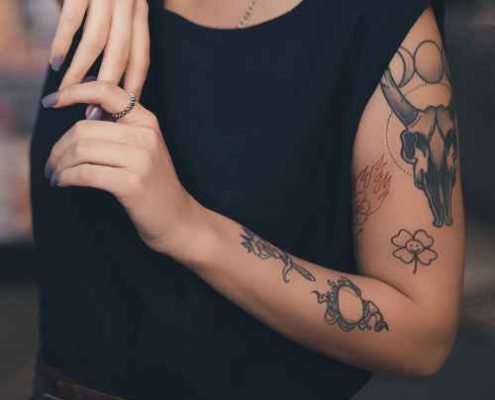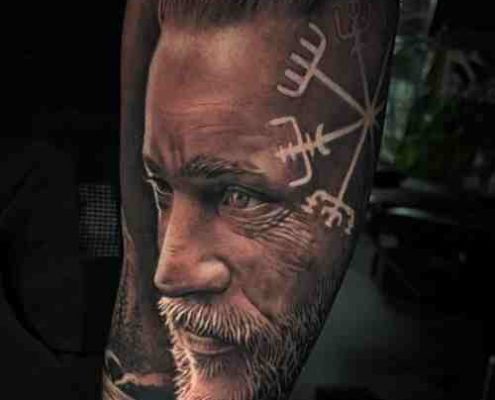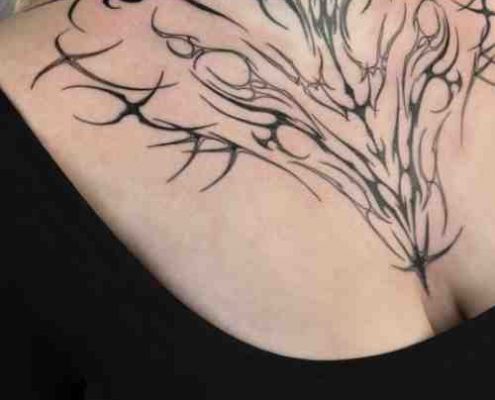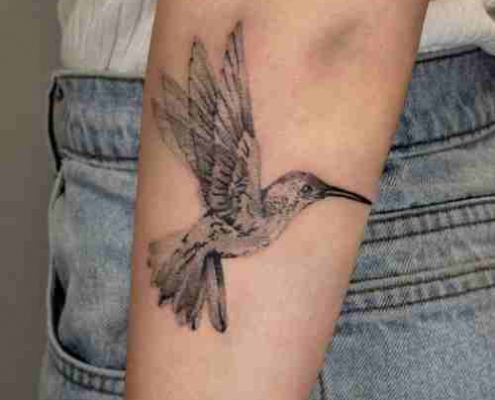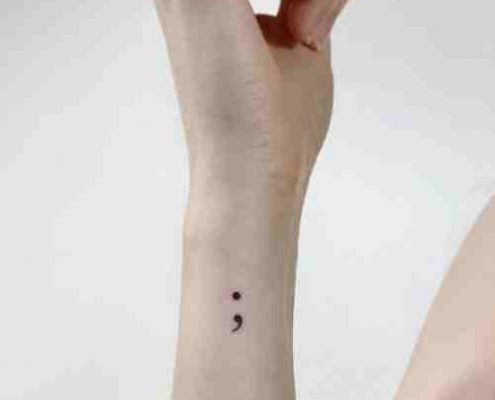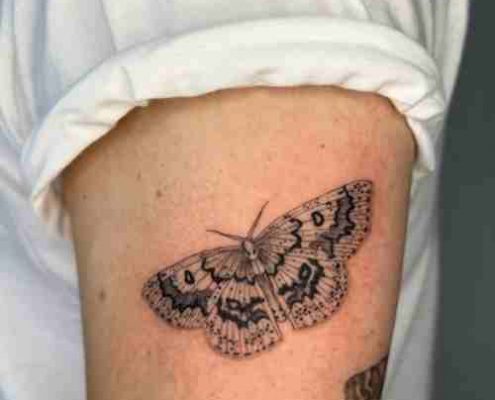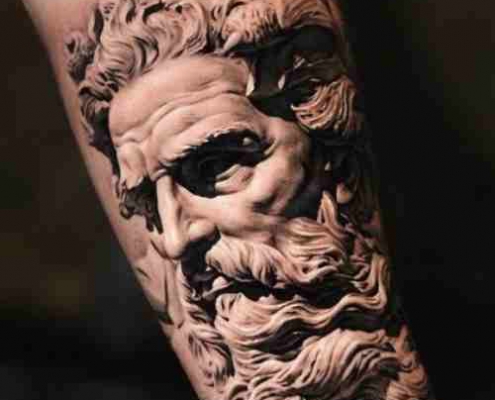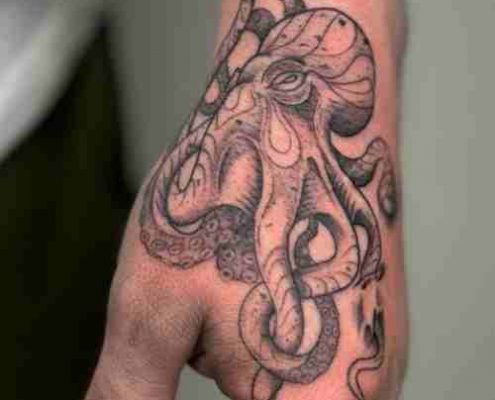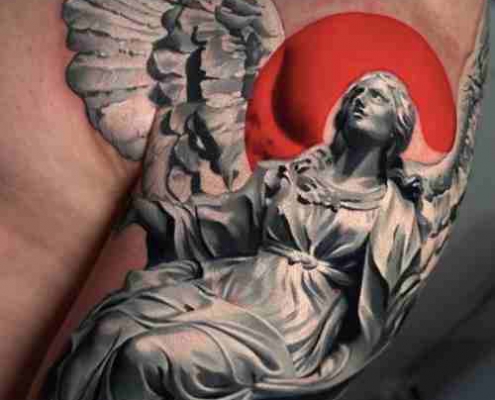Tribal Tattoo Guide – Polynesian, African, Native American Tattooing
Tribal tattoo designs are not a thing of trend. They represent a collective art heritage of many cultures around the world.
From Africa, the cradle of humanity, spread across all continents, tribes have used tattooing to mark the right of passage, big achievements, status, and protection.
That said, getting a tribal tattoo is an intrinsically meaningful act.
Historically, it’s a way to put protective or therapeutic symbols on the person of the tribe, or to emphasize their social, political or religious status in the tribe. Occasionally it was also a form of self-expression by getting a spirit animal tattoo for example.
The tribal tattoos had gone through many transformations through the years, and the artistic self-expression is the common reason to get a tribal tattoo done today, making them one of the most popular tattoo styles for people looking to get a custom tattoo design.
Below we try to make an overview of some of the most important tribal styles, as well as most popular tribal tattoos symbols.
Let’s dive in!
Tribal Tattoo Style – History
The history of tribal tattoos is the history of tattoos in itself.
Ancient Egyptian mummies are the oldest pair of humans who are known to have had tattoos. Both individuals date anywhere from 3351 B.C. to 3017 B.C.
The next known example of ancient Egyptians getting tattoos doesn’t appear for more than a millennia later.
They can only be joined in the club by the Ötzi the Ice Man, a cave man dating back to about 3370 B.C., has earlier evidence of tattoos.
These earliest examples are helping researches understand the history of tattoos and how and why body modification started.
The art of tattooing was popular in cultures across the globe, until the European colonialism tried to put a stop to it.
In one of the most well-known tattoo cultures, the highly skilled tattooists of Samoa continue to create their art as it was carried out in ancient times, prior to the invention of modern tattooing equipment.
Various cultures throughout Africa also employ tattoos, including the fine dots on the faces of Berber women in Algeria, the elaborate facial tattoos of Wodabe men in Niger and the small crosses on the inner forearms which mark Egypt’s Christian Copts.
Across the indigenous world, tribal peoples rarely describe tattooing as an artistic or aesthetic practice because there are no terms for ‘art’ or ‘artist’ in the majority of indigenous languages.
Given that it’s not just art for them, tattooing is actually integral to the life in the indigenous communities and their religions, for both women and men.
For them, it is a cultural, clan, or family-mandated ritual that showcases their most important values on the skin for all to see.
Nowadays, we have a modern interpretation of tribal tattoos through so called cyber sigilism tattoo style – with similar sharp angles, thin lines, but without the connection to a specific culture.
Placement of Tribal Tattoos
Today’s admirers of tribal tattoos – either members of tribes in question or other tattoo lovers – especially appreciate the art of creating a tribal tattoo sleeve.
The sleeves, whether half or full tattoo sleeves, are a big sized canvas to give liberty to the artist to create a meaningful tattoo piece.
Other great options, that are also historically common, are tribal shoulder tattoo pieces or getting a tribal band tattoo. Similarly, a tribal leg tattoo is a great choice.
As a way to represent a body, many go for a tribal chest tattoo.
In the Maori culture of New Zealand, the head was considered the most important part of the body.
This paved the way for the most well known tribal face tattoos also known as ‘moko,’ which were regarded as marks of high status.
In ancient Egyptian tattooing, there is also the example of placing tattoos on the bellies of women as a means of safeguarding women during pregnancy and birth.
African Tribal Tattoos
African tribal tattoos have a complex and long history. Any body modification in the oldest continent are not just an aesthetic, they represent tribal affiliation and the status in the said tribe.
Modifications – piercings and epidermal altercations – are methods of curing disease, wards against spirits and reflections of one’s own personality.
They are usually categorized into two significant groups.
The common tribal body modification in the North African states, such as Morocco, Algeria, Libya, and Egypt, and in some Sub-Saharan Africa was scarification, which is the process of cutting deep into the skin enough to cause permanent marking.
In more recent times due to the a large population following the religion of Islam, tattooing has been considered disrespectful and unholy.
Subsequently, henna tattoos prevailed in these societies as they are temporary, and even date back to the first ever being used in ancient Egypt around 9000 BCE.
In the sub-Saharan regions, modern day tattoo artists are now reviving the tattoo culture, giving it a modern touch using modern tattoo equipment.
These artists, along with the African diaspora tattoo artists, also tattoo common African tribe symbols on their clients, creating a growing portfolio of contemporary African tribal tattoos.
Pacific Tribal Tattoos – Polynesian, New Zealand, Filipino
Pacific tribal tattoo styles are definitely going through a revival and represent a very popular tattoo design, especially for men.
These different tribal tattooing cultures boast a vast history and archives.
These styles can be categorized into geographical groups, so Polynesian tattoos can either be Maori of New Zealand, Samoan, Hawaiian, Marquesans and so on.
Then in the Philippines, tattoos can either be Kalinga, Ibaloi, Visayan, Manobo and so on.
Most popular are still the Polynesian tattoos.
Their legacy began over 2000 years ago and is as diverse as the people who wear them.
Once widespread in Polynesian societies across the Pacific Ocean, the arrival of western missionaries in the 19th century forced this unique art form into decline.
The Christian religious missionaries have worked on banning tattooing, deeming it as unholy.
Nevertheless, many Polynesian tattoo artists maintained their vital link to their culture’s history by preserving their unique craft for generations.
Native American Tribal Tattoos
Native American tattoos nowadays are mostly associated with realistic tattoos of Native American women or chiefs in headdresses.
However, the Native American tattooing culture actually started thousands of years ago.
America is a large continent, and thus was a home to many tribes across its vast land.
Even so distant one from another, almost all Native tribes practiced the art of tattooing and had their unique tribal patterns emerge from it.
Undisturbed by the Christian faith, who denounced tattooing as barbaric and sacrilegious in the mid 700s AD, the Native American tribes believed tattooing to be sacred, spiritual, and incorporated the practice into their everyday lives.
However, each area’s practices were slightly different.
Most popular among the typical tribal tattoos from Americas are the Haida tribal tattoos.
The Haida people based a lot of its culture on tattooing, and they were one of the first to ink in color using the colors red and black.
Traditional Haida tattoos known as ki-da were worn on the forearms, chest, thighs, upper arms, feet and sometimes on finger sections or a person’s back.
Apart from them, there is a lot of Native American art and patterns that have regularly appeared in their tattoo style – both in ancient times, as well as in the contemporary Native American tribal tattoo art.
How Will A Tribal Tattoo Age?
Tribal tattoos have been around for thousands of years, and the practices and designs have been in specific designed to heal well and last long.
Looking at older tribal tattoo examples, we can notice that they still look just as amazing as when they were initially done, apart for the loss in the intensity of the color.
Tribal tattoos have certain elements that almost guarantee their longevity:
- They usually feature strong, thick lines which are more likely to heal better and last longer
- They rarely feature color which makes their color change over time be very slight
- Many of tribal tattoos feature more simpler designs that heal better unlike very busy and dense colorful tattoo designs
Tribal Tattoo Ideas
To help you with your research for your next tattoo design, below you will find our best tribal tattoo designs from our tattoo guides and the Instagram.
Click on the headline to learn more about each tattoo symbol.
Take a look below to check them out all:
Tribal Dragon Tattoo
Tribal Turtle Tattoo
Are you looking for a custom tribal tattoo design? We got you.
Our expert tattoo artists will provide a quick initial draft to get you going.
Happy inking ❤
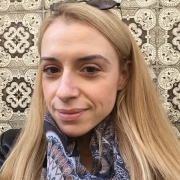
Milena Petrovic
About the author
Milena has decided to start an organization that will create a safe environment for everybody to get their first, second or third tattoo and to encourage young people to transform their ideas into tattoos safely, with talent and vision.
You can find her writing about tattoos on Quora or updating our Pinterest profile with awesome tattoo ideas!



